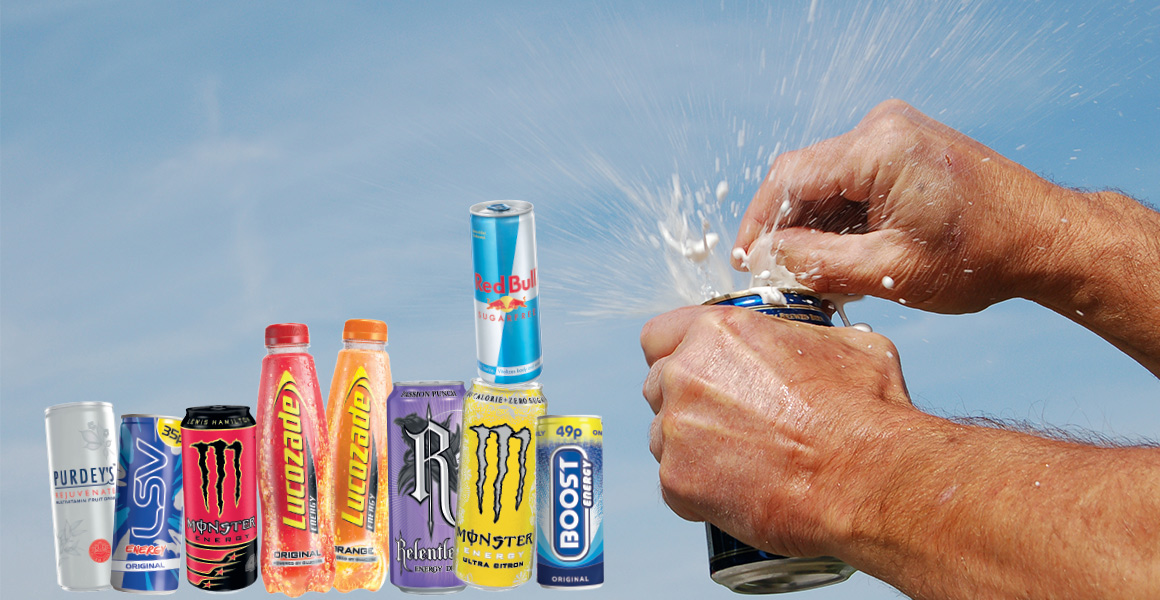A great energy drinks range is crucial in all convenience stores. Nikki Allen finds out how you can tap into the latest trends.
Select a strong core range
The energy drinks sector is rife with launches, new formats and flavours, meaning there’s a huge range of products on offer. But to succeed in the category, you need to stock a range of core lines from bestselling brands and make the fixture simple to shop.
Rich Fisher, category development manager at Red Bull, says retailers should make sure they are giving the top lines the right amount of shelf space.
“Red Bull Energy 250ml is worth £135.8m and growing at 2%, making it a must stock for retailers,” he says.
By stocking the bestselling lines of the top brands, you can appeal to the majority of your customers and drive sales. Scott Meredith, sales director at Lucozade Ribena Suntory, says: “The average store makes more than £2,500 a year in sales of Lucozade Energy drinks.”
Monster Energy is another key brand for retailers, which is growing at 23% year on year. Amy Burgess, CCEP trade communications manager, says: “Monster has delivered the greatest value growth out of the top-10 soft drinks, at £23.8m.”
Your EPoS data will also prove a valuable source of data to work out what your core range is. If you find you are regularly restocking a particular brand, consider adding another facing.
Provide low-sugar options
The harm that sugar can cause has been well-documented in the media in recent years and, with the soft drinks levy coming into force from April, you should be prepared for the demand in low-sugar alternatives.
Adrian Troy, AG Barr marketing director, says: “The low-calorie big can energy market is currently growing at 29% and is set to continue for the next five years.”
Offering healthier choices is an important part of responsible retailing and can also help you appeal to a broader range of customers. Lucozade Ribena Suntory’s Scott Meredith says: “Consumers are more interested in making healthier choices than ever, so retailers should capitalise on these changing habits with their range.”
“It’s important to offer a low-calorie alternative,” agrees Red Bull’s Rich Fisher. “Diet is worth more than £100m, which is 8.4% of the sports & energy category, increasing by 3.5% from last year.”
This trend towards health also opens up new opportunities to drive sales of functional vitamin drinks. Trystan Farnworth, Britvic convenience & impulse commercial director, says: “We’re seeing consumers increasingly reject the many existing products in the category because they are dissatisfied with a short-term boost followed by a ‘crash’ in energy.”
Stock price-marked packs
Price-marked packs (PMP) are a great way to communicate value to your shoppers. You might not need to offer everything in PMPs, but stocking a good range gives the impression of fair prices overall.
“PMPs make absolute sense for independent retailers – as long as the retail price is competitive and the margin is maintained,” says Simon Gray, founder and managing director of Boost Drinks.
“Research shows consumers prefer PMPs and they help independents compete effectively by offering a price in line with the multiples.”
More than half of the soft drinks market is driven by PMPs. Lucozade Ribena Suntory’s Scott Meredith says PMPs are incredibly important when it comes to showing value to energy drink shoppers.
“We also know that soft drink PMPs have a faster rate of sale than non-PMPs and this rate of sale is increasing, up 5.5% in the past year,” he says.
Red Bull’s Rich Fisher says: “We recommend that independent and symbol retailers stock PMPs across bestsellers at all times, to demonstrate range and offer shoppers choice, while driving cash sales.”
Choose top formats
Different sizes and formats are pushing sales in the energy drinks category forward and are unlikely to take away sales from your core range. “Big can formats are driving growth at 15%, with flavoured varieties playing a significant role in the success,” says AG Barr’s Adrian Troy.
However, sizes are currently under-represented on retailers’ shelves compared to their share of sales.
“Product size is the first or second most-important decision for a consumer, after which brand to choose,” says Red Bull’s Rich Fisher. “Both size and diet are driving the category, so by offering different sizes and charging a premium, retailers can make sure they are maintaining value.”
Stocking different sizes can also help retailers drive their overall category as sizes contribute 79.1% of energy drink’s growth. Fisher says: “Not only will different sizes not steal share from the core lines, but they can also deliver additional rate of sale.”
Retailer View
 “Energy is a big part of our drinks range, making up about 60% of our overall soft drinks sales.
“Energy is a big part of our drinks range, making up about 60% of our overall soft drinks sales.
“We offer a good choice of sugar-free varieties and stock them next to the original ones. I think it’s important to offer people an alternative rather than forcing them just to buy sugar-free drinks.
“Our core market for energy drinks is workers. Our store is in a factory area and there are lots of builders working nearby, so they will often come in and pick up a can to help them keep going all day.
“We are also a responsible retailer, so we are careful never to sell energy drinks to under-14s.”
Samantha Coldbeck,
Wharfedale Premier, Hull





Comments
This article doesn't have any comments yet, be the first!